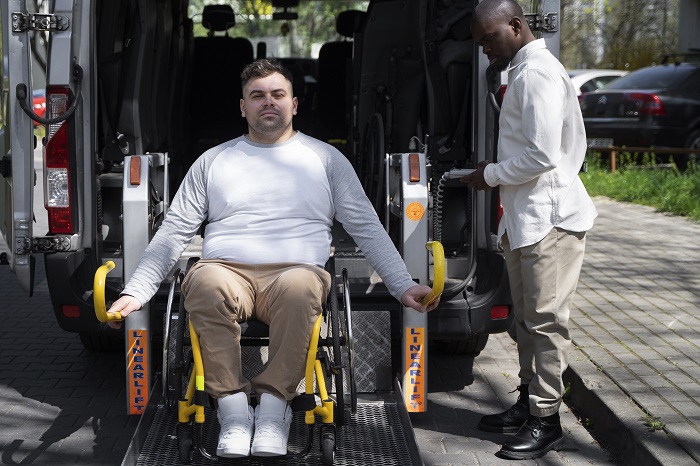Wheelchair-accessible taxis are becoming more important. Big changes are happening in transportation. More of these taxis show a real effort to include everyone and improve how people move around.
Businesses see new ways to grow as they notice the value of these services. New ideas are popping up that were not possible before.
This article explores how the rise of wheelchair-accessible taxis is helping companies grow, probably making customers happier and moving the market forward.
The Increasing Demand for Accessible Transportation
The transportation sector has a notable shift towards more inclusive options. The need for accessible taxis for wheelchair users has surged dramatically, driven by societal changes and heightened awareness of the needs of individuals with mobility challenges.
As a result, innovation in wheelchair accessible taxis has become an essential focus for businesses aiming to meet these demands. Companies that adapt to these trends can attract a diverse customer base, fostering loyalty, and setting themselves apart from competitors.
By providing mobility-friendly taxis that are designed with accessibility in mind, businesses comply with legal obligations and enhance their brand reputation.
Local authorities prioritising accessible transport often seek partnerships with companies demonstrating a commitment to inclusion. This collaboration creates an incredibly beneficial scenario where businesses gain new clientele while communities receive much-needed mobility services.
How Wheelchair Accessible Taxis Are Fostering Innovation
The growing demand for accessible taxis propels transportation companies to innovate both in technology and design. Many businesses are investing heavily in electric and hybrid vehicles because they recognise their environmental benefits as well as their appeal to eco-conscious customers.
This trend extends beyond just vehicle types. Inclusive designs are emerging that incorporate features specifically enhancing accessibility for wheelchair users.
As anticipated, digital transformation is critical in this evolution. Companies leverage mobile applications and GPS technology to simplify their essential services, ensuring that booking accessible taxis as modes of transport is straightforward and pretty convenient.
This simplification eases travel for individuals with disabilities and positions companies as leaders in the movement towards greater accessibility, fostering innovation throughout the entire industry.
Benefits of Incorporating Accessible Taxis into Business Operations
Integrating wheelchair-accessible taxis into a company’s fleet can yield considerable benefits:
New Revenue Streams
By attracting a broader customer range, including those who depend on accessible transport options, companies can grow their income.
This demographic includes individuals with disabilities and their families, caregivers, and organisations supporting mobility-impaired individuals.
Local authorities, schools, and healthcare facilities are also potential clients looking for reliable transport solutions to meet their transportation needs.
Corporate Social Responsibility (CSR)
Investing in electric vehicles for disabled people reflects a company’s commitment to inclusivity and community support. This dedication resonates with consumers who prioritise ethical and socially responsible brands.
Positive Customer Experiences
Providing accessible transport options improves the travel experience for passengers with disabilities. When customers feel valued and understood, they are more likely to become repeat clients.
Satisfied customers are inclined to share their positive experiences through social media or personal recommendations—fostering a cycle of word-of-mouth marketing that can bolster a company’s standing in the market.
Competitive Advantage
As more consumers demand accessible transport options, businesses that integrate wheelchair-accessible taxis can stand out from competitors. This differentiation can lead to increased market share—particularly in areas with high demand for inclusive services.
From a corporate perspective—the investment in accessible vehicles not only meets regulatory obligations but also positions the company as a leader in social responsibility.
Key Challenges and Solutions for Taxi Companies
While the advantages of inclusive transport options are clear—taxi companies may encounter several challenges when incorporating these vehicles into their fleets.
Initial costs associated with acquiring specialised vehicles can pose significant barriers. However, viable solutions exist:
- Financial Assistance: Government grants and partnerships with local authorities can help offset costs—making the transition more manageable.
- Driver Training: Training drivers to effectively accommodate passengers with disabilities is crucial for ensuring high service levels. This training enhances the customer experience—and empowers drivers to assist passengers effectively.
- Maintenance and Upkeep: Wheelchair-accessible vehicles may require more regular maintenance due to their specialised nature; implementing robust preventative maintenance programmes reduces long-term costs—and ensures vehicle reliability.
Future Trends in Accessible Transportation
The future of wheelchair-friendly taxis looks bright. Driverless cars bring new ways to help people get around. This could drop prices and help things run smoother as tech gets better. More tools may appear like smartphone apps made for people with disabilities.
Companies that start preparing now will probably lead the way tomorrow. More people want transport that works for everyone. Trying new ideas now might change how public transport looks later!








Got a Questions?
Find us on Socials or Contact us and we’ll get back to you as soon as possible.